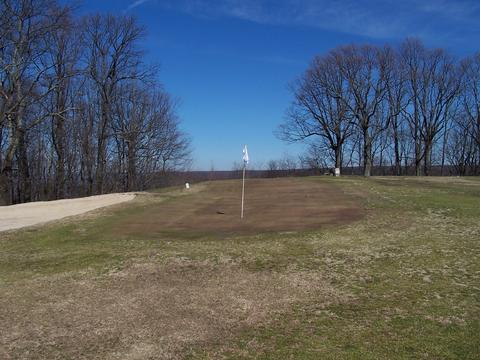
The 4th hole at Sewanee Golf Club in Tennessee featured the narrowest green I had ever played.
Today marks the first anniversary of GolfCommunityReviews. By my calculations, we have produced more than 350 separate articles here over the last 365 days, a mix of reviews, observations and the occasional rant. For those contemplating a move to a golf community in the southern U.S., I hope we have provided some food for thought, some cautionary tales as well as some confidence about making the move. Moreover, we hope we have armed you with some questions to ask when you visit a community or work with a real estate agent. Please note, we maintain a network of agents we have qualified as most knowledgeable about all the communities in their area. We are currently working with three couples looking for their dream homes on the course.
As I look back on this first year, here are the highlights:
The saddest few minutes of the year hit us on the drive up the 18th hole at Tom Fazio's Ocean Links course at Wild Dunes on Isle of Palms, SC. During the first week in August when we played the entertaining course, giant white sand bags along the fairway and at greenside obscured some views of the ocean and appeard to be
The college application and matriculation process for my son was a boon to my discovery of some out of the way but excellent golf courses. On a college visit to Sewanee, TN, last February, we stopped to play at the local nine hole Sewanee Golf Club, which was built by members and college faculty more than 50 years ago. The highlight of the course was what could be the narrowest green in America, the par three 4th hole which was perched on the edge of the mountain. At its front, where the pin was located on the day we played, it was not more than eight yards across. Back to front, the green measured about 120 feet; a back pin position was no more than 10 yards from the edge of the mountain, unprotected by fence, wall or vegetation...
Later, we would play both the Vista Links course in Buena Vista, VA, six miles from Washington & Lee University, my son's eventual college choice, and the Lexington Golf Club, just a mile from the school. My son and his golf team use Vista Links for practice rounds and Lexington for one tournament a year. Both were delightful surprises, Vista a wide open sweeping layout by Rick Jacobson with great views of the Shenandoah Mountains, and Lexington, a classic Ellis Maples layout that threads its way through the woods and whose finishing hole over water to a small green perched on a hill was one of the toughest I played all year...
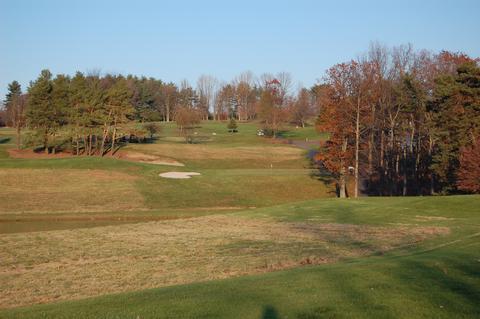
The 15th hole at Sugarloaf in Pennsylvania is a monster, with little room for bailout.
On a trip from Connecticut back to Lexington after Thanksgiving recess, we stopped a few miles from I-81 in Pennsylvania at the Sugarloaf Golf Club, a Geoffrey Cornish design near the town of Sugarloaf. Cornish designed our home course of Hop Meadow in Connecticut, and we were curious about playing another course with similar provenance. We were not disappointed in the classic mountain layout, but we were taken aback by the par 3 15th, the toughest three-stroke hole either of us had ever played, a 260-yard monster from the tips over a ravine and water to a sloping green with a false front...
The year brought some other pleasant surprises as well, as at the North Hampton Golf Club in Fernandina Beach, FL, the first Arnold Palmer design I had ever played that wasn't ham-fisted in its use of bunkering and slopes. Part links-type course, part parkland, North Hampton combined the best of both. I almost didn't notice the homes surrounding the course...
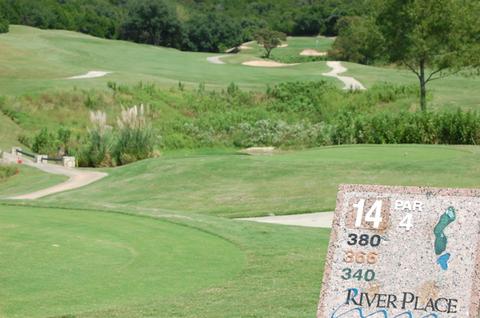
The par 4 14th hole at River Place is but one of many whose sloping fairways make placement difficult on the Austin course.
I made my first "research" trip west of the Mississippi River, to Austin, TX, where an online survey I had taken a few years ago had told me I wanted to live (i.e. The Texas Hill Country). My wife took the same survey and found she truly wanted to live in New York, Boston or San Francisco. She says she'll miss me. Seriously, though, Austin has terrific golf courses, wonderful hill views (like San Francisco), a carefree attitude and a budding traffic problem (an issue with virtually all towns whose populations have grown faster than their abilities to plan). One morning I passed a traffic jam a half hour from the city. All courses in the Austin area offered great views and differing golfing experiences. Most memorable, from a visual standpoint, was River Place, whose dramatic ups and downs were too extreme when it first opened in the early 1980s; the course was redone after just two years of operation. Although I had been forewarned that the course was "tricked up" and I was annoyed at losing a few balls on "blind" shots to fairways, I found River Place enough of a challenge to want to give it another go someday...
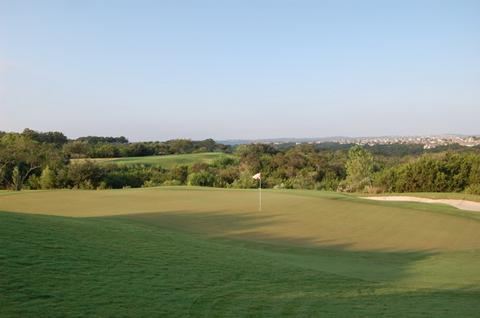
The view from behind the 2nd green at the University of Texas Golf Club is typical of others on the course.
But the best layout and country club experience for me in the Austin area was the University of Texas Golf Club, a Bechtol-Russell design that wove its way through the huge Steiner Ranch community. I just wish I had thought to wear something orange so I could have blended in a little better. This is "horns (as in Texas Longhorns) territory, and the university's symbols and burnt orange colors are everywhere, even around the mirrors in the rest rooms out on the course. Typically, I'll downgrade a course with homes so close to its perimeter - especially homes that are literally 10 to 15 yards from each other - but at the UT Club, the homes were either well above or well below the fairways, making it appear they weren't as close as they actually were, really a masterwork of golf community course design. Sadly, UT suffered a disaster of its own last month when its almost-completed $16 million clubhouse burned to the ground. If the positive attitude I encountered with every employee I met is a predictor, a second clubhouse will open by the end of the year, as club officials have promised...
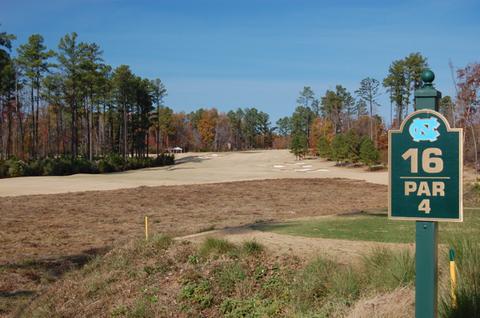
Chapel Hill has many positive attractions, not least The Finley Golf Club.
Speaking of universities, the University of North Carolina has a pretty fair track itself, The Finley Golf Club, located in a town that has everything except a beach. Chapel Hill is the ultimate college town, with not only UNC but also Duke and NC State an easy drive away. Sports, adult education, a hip vibe and great restaurants, as well as real estate that hadn't quite skyrocketed before the housing bust - and hasn't plummeted since -- make it my favorite pick for anyone willing to wear a sweater on the golf course a few days during the winter.
If you are interested in Chapel Hill or any place else, please contact us. We maintain contacts with well-qualified real estate agents throughout the southern U.S. At no cost or obligation to you whatsoever, we can put you in touch with someone who knows all the golfing communities and private courses in their local area. This will save you time and research during the sometimes arduous process of finding your dream home on the course.
Thank you for visiting GolfCommunityReviews.com, and please do not hesitate to make suggestions on how we can improve the site.























